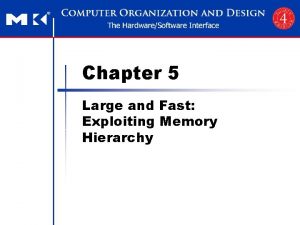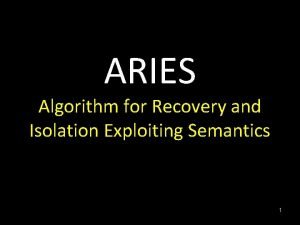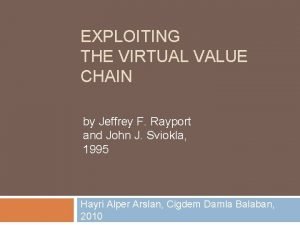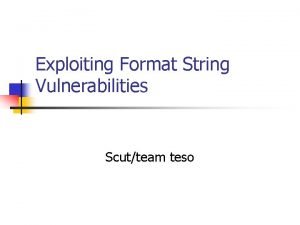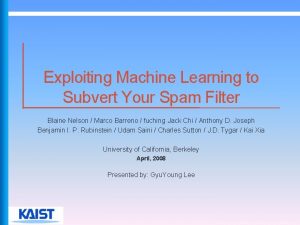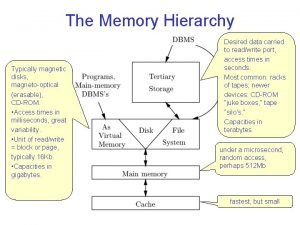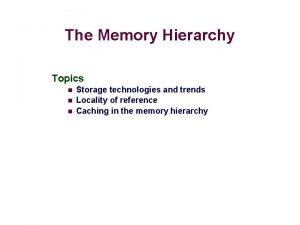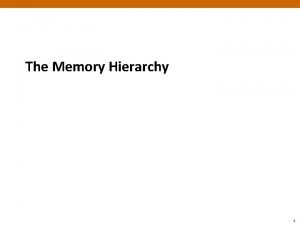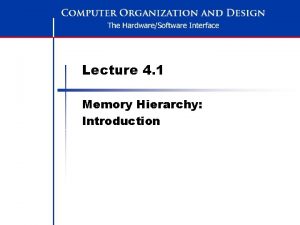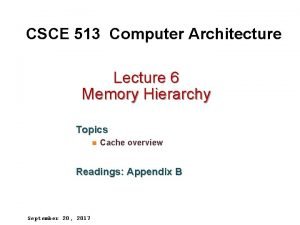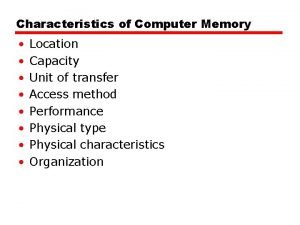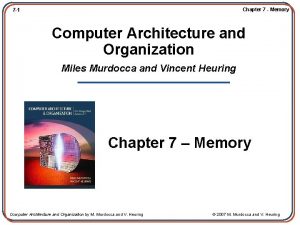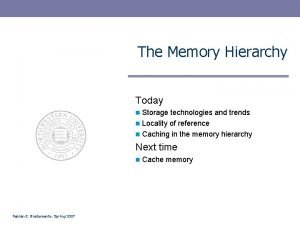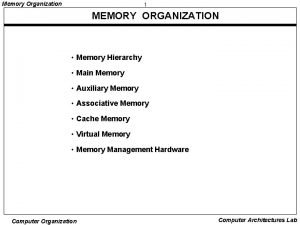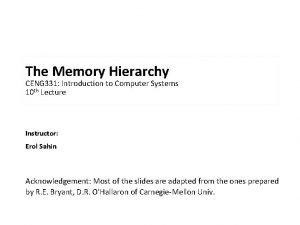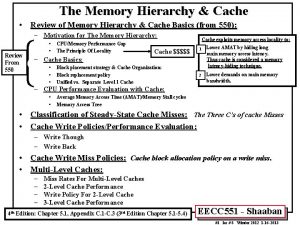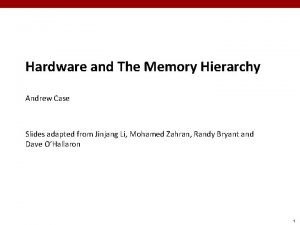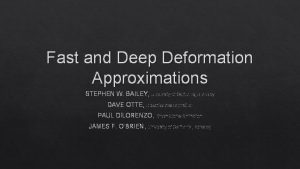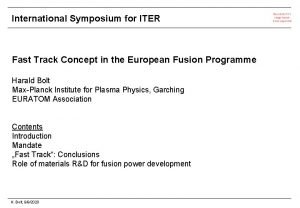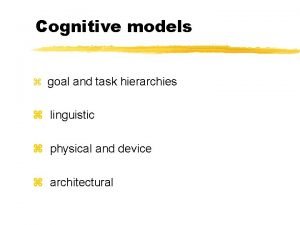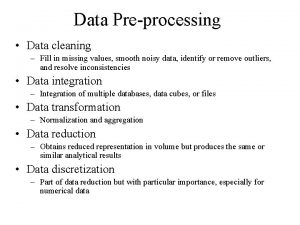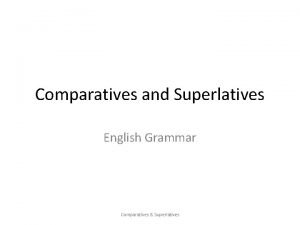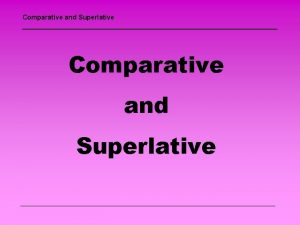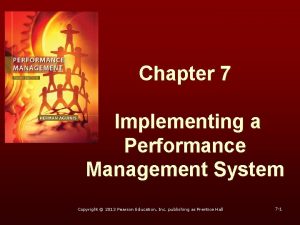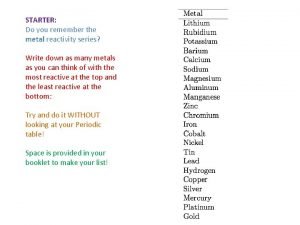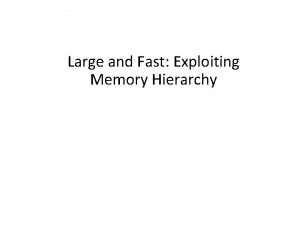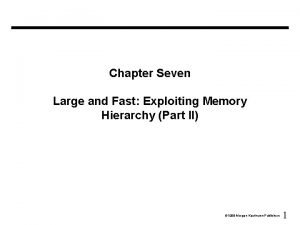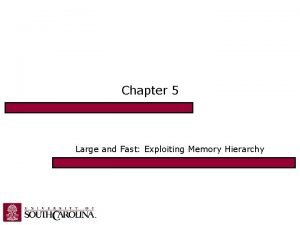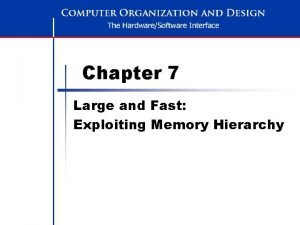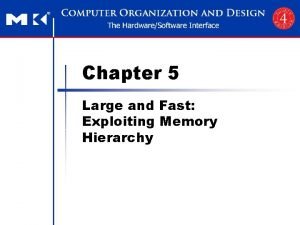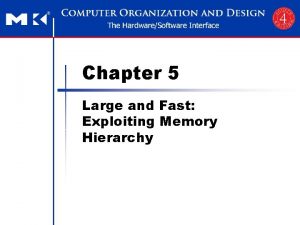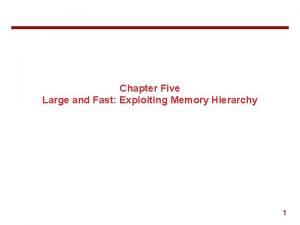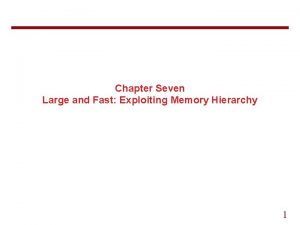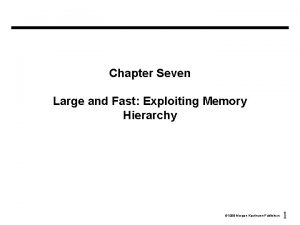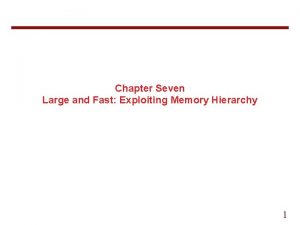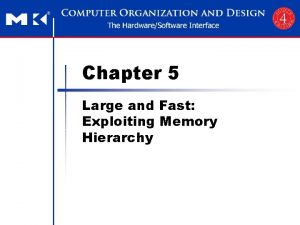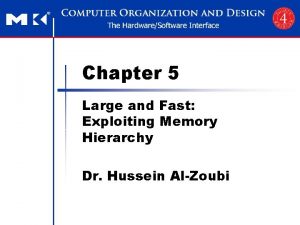Chapter 5 Large and Fast Exploiting Memory Hierarchy













































































- Slides: 77

Chapter 5 Large and Fast: Exploiting Memory Hierarchy

n n Programs access a small proportion of their address space at any time Temporal locality n n n § 5. 1 Introduction Principle of Locality Items accessed recently are likely to be accessed again soon e. g. , instructions in a loop, induction variables Spatial locality n n Items near those accessed recently are likely to be accessed soon E. g. , sequential instruction access, array data Chapter 5 — Large and Fast: Exploiting Memory Hierarchy — 2

Taking Advantage of Locality n n n Memory hierarchy Store everything on disk Copy recently accessed (and nearby) items from disk to smaller DRAM memory n n Main memory Copy more recently accessed (and nearby) items from DRAM to smaller SRAM memory n Cache memory attached to CPU Chapter 5 — Large and Fast: Exploiting Memory Hierarchy — 3

Memory Hierarchy Levels n Block (aka line): unit of copying n n May be multiple words If accessed data is present in upper level n Hit: access satisfied by upper level n n Hit ratio: hits/accesses If accessed data is absent n Miss: block copied from lower level n n n Time taken: miss penalty Miss ratio: misses/accesses = 1 – hit ratio Then accessed data supplied from upper level Chapter 5 — Large and Fast: Exploiting Memory Hierarchy — 4

n Static RAM (SRAM) n n Dynamic RAM (DRAM) n n 50 ns – 70 ns, $20 – $75 per GB Magnetic disk n n 0. 5 ns – 2. 5 ns, $2000 – $5000 per GB § 5. 2 Memory Technologies Memory Technology 5 ms – 20 ms, $0. 20 – $2 per GB Ideal memory n n Access time of SRAM Capacity and cost/GB of disk Chapter 5 — Large and Fast: Exploiting Memory Hierarchy — 5

DRAM Technology n Data stored as a charge in a capacitor n n Single transistor used to access the charge Must periodically be refreshed n n Read contents and write back Performed on a DRAM “row” Chapter 5 — Large and Fast: Exploiting Memory Hierarchy — 6

Advanced DRAM Organization n Bits in a DRAM are organized as a rectangular array n n n Double data rate (DDR) DRAM n n DRAM accesses an entire row Burst mode: supply successive words from a row with reduced latency Transfer on rising and falling clock edges Quad data rate (QDR) DRAM n Separate DDR inputs and outputs Chapter 5 — Large and Fast: Exploiting Memory Hierarchy — 7

DRAM Generations Year Capacity $/GB 1980 64 Kbit $1500000 1983 256 Kbit $500000 1985 1 Mbit $200000 1989 4 Mbit $50000 1992 16 Mbit $15000 1996 64 Mbit $10000 1998 128 Mbit $4000 256 Mbit $1000 2004 512 Mbit $250 2007 1 Gbit $50 Chapter 5 — Large and Fast: Exploiting Memory Hierarchy — 8

DRAM Performance Factors n Row buffer n n Synchronous DRAM n n n Allows several words to be read and refreshed in parallel Allows for consecutive accesses in bursts without needing to send each address Improves bandwidth DRAM banking n n Allows simultaneous access to multiple DRAMs Improves bandwidth Chapter 5 — Large and Fast: Exploiting Memory Hierarchy — 9

n Nonvolatile semiconductor storage n n n 100× – 1000× faster than disk Smaller, lower power, more robust But more $/GB (between disk and DRAM) § 6. 4 Flash Storage Chapter 6 — Storage and Other I/O Topics — 10

Flash Types n NOR flash: bit cell like a NOR gate n n n NAND flash: bit cell like a NAND gate n n Random read/write access Used for instruction memory in embedded systems Denser (bits/area), but block-at-a-time access Cheaper GB Used for USB keys, media storage, … Flash bits wears out after 1000’s of accesses n n Not suitable for direct RAM or disk replacement Wear leveling: remap data to less used blocks Chapter 6 — Storage and Other I/O Topics — 11

n Nonvolatile, rotating magnetic storage § 6. 3 Disk Storage Chapter 6 — Storage and Other I/O Topics — 12

Disk Sectors and Access n Each sector records n n n Sector ID Data (512 bytes, 4096 bytes proposed) Error correcting code (ECC) n n n Used to hide defects and recording errors Synchronization fields and gaps Access to a sector involves n n n Queuing delay if other accesses are pending Seek: move the heads Rotational latency Data transfer Controller overhead Chapter 6 — Storage and Other I/O Topics — 13

Disk Access Example n Given n n Average read time n n 512 B sector, 15, 000 rpm, 4 ms average seek time, 100 MB/s transfer rate, 0. 2 ms controller overhead, idle disk 4 ms seek time + ½ / (15, 000/60) = 2 ms rotational latency + 512 / 100 MB/s = 0. 005 ms transfer time + 0. 2 ms controller delay = 6. 2 ms If actual average seek time is 1 ms n Average read time = 3. 2 ms Chapter 6 — Storage and Other I/O Topics — 14

Disk Performance Issues n Manufacturers quote average seek time n n n Smart disk controller allocate physical sectors on disk n n n Based on all possible seeks Locality and OS scheduling lead to smaller actual average seek times Present logical sector interface to host SCSI, ATA, SATA Disk drives include caches n n Prefetch sectors in anticipation of access Avoid seek and rotational delay Chapter 6 — Storage and Other I/O Topics — 15

n Cache memory n n The level of the memory hierarchy closest to the CPU § 5. 3 The Basics of Caches Cache Memory Given accesses X 1, …, Xn– 1, Xn n n How do we know if the data is present? Where do we look? Chapter 5 — Large and Fast: Exploiting Memory Hierarchy — 16

Direct Mapped Cache n n Location determined by address Direct mapped: only one choice n (Block address) modulo (#Blocks in cache) n n #Blocks is a power of 2 Use low-order address bits Chapter 5 — Large and Fast: Exploiting Memory Hierarchy — 17

Tags and Valid Bits n How do we know which particular block is stored in a cache location? n n Store block address as well as the data Actually, only need the high-order bits Called the tag What if there is no data in a location? n n Valid bit: 1 = present, 0 = not present Initially 0 Chapter 5 — Large and Fast: Exploiting Memory Hierarchy — 18

Cache Example n n 8 -blocks, 1 word/block, direct mapped Initial state Index V 000 N 001 N 010 N 011 N 100 N 101 N 110 N 111 N Tag Data Chapter 5 — Large and Fast: Exploiting Memory Hierarchy — 19

Cache Example Word addr Binary addr Hit/miss Cache block 22 10 110 Miss 110 Index V 000 N 001 N 010 N 011 N 100 N 101 N 110 Y 111 N Tag Data 10 Mem[10110] Chapter 5 — Large and Fast: Exploiting Memory Hierarchy — 20

Cache Example Word addr Binary addr Hit/miss Cache block 26 11 010 Miss 010 Index V 000 N 001 N 010 Y 011 N 100 N 101 N 110 Y 111 N Tag Data 11 Mem[11010] 10 Mem[10110] Chapter 5 — Large and Fast: Exploiting Memory Hierarchy — 21

Cache Example Word addr Binary addr Hit/miss Cache block 22 10 110 Hit 110 26 11 010 Hit 010 Index V 000 N 001 N 010 Y 011 N 100 N 101 N 110 Y 111 N Tag Data 11 Mem[11010] 10 Mem[10110] Chapter 5 — Large and Fast: Exploiting Memory Hierarchy — 22

Cache Example Word addr Binary addr Hit/miss Cache block 16 10 000 Miss 000 3 00 011 Miss 011 16 10 000 Hit 000 Index V Tag Data 000 Y 10 Mem[10000] 001 N 010 Y 11 Mem[11010] 011 Y 00 Mem[00011] 100 N 101 N 110 Y 10 Mem[10110] 111 N Chapter 5 — Large and Fast: Exploiting Memory Hierarchy — 23

Cache Example Word addr Binary addr Hit/miss Cache block 18 10 010 Miss 010 Index V Tag Data 000 Y 10 Mem[10000] 001 N 010 Y 10 Mem[10010] 011 Y 00 Mem[00011] 100 N 101 N 110 Y 10 Mem[10110] 111 N Chapter 5 — Large and Fast: Exploiting Memory Hierarchy — 24

Address Subdivision Chapter 5 — Large and Fast: Exploiting Memory Hierarchy — 25

Example: Larger Block Size n 64 blocks, 16 bytes/block n n n To what block number does address 1200 map? Block address = 1200/16 = 75 Block number = 75 modulo 64 = 11 31 10 9 4 3 0 Tag Index Offset 22 bits 6 bits 4 bits Chapter 5 — Large and Fast: Exploiting Memory Hierarchy — 26

Block Size Considerations n Larger blocks should reduce miss rate n n Due to spatial locality But in a fixed-sized cache n Larger blocks fewer of them n n n More competition increased miss rate Larger blocks pollution Larger miss penalty n n Can override benefit of reduced miss rate Early restart and critical-word-first can help Chapter 5 — Large and Fast: Exploiting Memory Hierarchy — 27

Cache Misses n n On cache hit, CPU proceeds normally On cache miss n n n Stall the CPU pipeline Fetch block from next level of hierarchy Instruction cache miss n n Restart instruction fetch Data cache miss n Complete data access Chapter 5 — Large and Fast: Exploiting Memory Hierarchy — 28

Write-Through n On data-write hit, could just update the block in cache n n n But then cache and memory would be inconsistent Write through: also update memory But makes writes take longer n e. g. , if base CPI = 1, 10% of instructions are stores, write to memory takes 100 cycles n n Effective CPI = 1 + 0. 1× 100 = 11 Solution: write buffer n n Holds data waiting to be written to memory CPU continues immediately n Only stalls on write if write buffer is already full Chapter 5 — Large and Fast: Exploiting Memory Hierarchy — 29

Write-Back n Alternative: On data-write hit, just update the block in cache n n Keep track of whether each block is dirty When a dirty block is replaced n n Write it back to memory Can use a write buffer to allow replacing block to be read first Chapter 5 — Large and Fast: Exploiting Memory Hierarchy — 30

Write Allocation n n What should happen on a write miss? Alternatives for write-through n n Allocate on miss: fetch the block Write around: don’t fetch the block n n Since programs often write a whole block before reading it (e. g. , initialization) For write-back n Usually fetch the block Chapter 5 — Large and Fast: Exploiting Memory Hierarchy — 31

n Components of CPU time n Program execution cycles n n Memory stall cycles n n Includes cache hit time Mainly from cache misses With simplifying assumptions: § 5. 4 Measuring and Improving Cache Performance Measuring Cache Performance Chapter 5 — Large and Fast: Exploiting Memory Hierarchy — 32

Cache Performance Example n Given n n n Miss cycles per instruction n I-cache miss rate = 2% D-cache miss rate = 4% Miss penalty = 100 cycles Base CPI (ideal cache) = 2 Load & stores are 36% of instructions I-cache: 0. 02 × 100 = 2 D-cache: 0. 36 × 0. 04 × 100 = 1. 44 Actual CPI = 2 + 1. 44 = 5. 44 n Ideal CPU is 5. 44/2 =2. 72 times faster Chapter 5 — Large and Fast: Exploiting Memory Hierarchy — 33

Average Access Time n n Hit time is also important for performance Average memory access time (AMAT) n n AMAT = Hit time + Miss rate × Miss penalty Example n n CPU with 1 ns clock, hit time = 1 cycle, miss penalty = 20 cycles, I-cache miss rate = 5% AMAT = 1 + 0. 05 × 20 = 2 ns n 2 cycles per instruction Chapter 5 — Large and Fast: Exploiting Memory Hierarchy — 34

Performance Summary n When CPU performance increased n n Decreasing base CPI n n Greater proportion of time spent on memory stalls Increasing clock rate n n Miss penalty becomes more significant Memory stalls account for more CPU cycles Can’t neglect cache behavior when evaluating system performance Chapter 5 — Large and Fast: Exploiting Memory Hierarchy — 35

Associative Caches n Fully associative n n Allow a given block to go in any cache entry Requires all entries to be searched at once Comparator per entry (expensive) n-way set associative n n Each set contains n entries Block number determines which set n n n (Block number) modulo (#Sets in cache) Search all entries in a given set at once n comparators (less expensive) Chapter 5 — Large and Fast: Exploiting Memory Hierarchy — 36

Associative Cache Example Chapter 5 — Large and Fast: Exploiting Memory Hierarchy — 37

Spectrum of Associativity n For a cache with 8 entries Chapter 5 — Large and Fast: Exploiting Memory Hierarchy — 38

Associativity Example n Compare 4 -block caches n n n Direct mapped, 2 -way set associative, fully associative Block access sequence: 0, 8, 0, 6, 8 Direct mapped Block address 0 8 0 6 8 Cache index 0 0 0 2 0 Hit/miss miss 0 Mem[0] Mem[8] Cache content after access 1 2 3 Mem[6] Chapter 5 — Large and Fast: Exploiting Memory Hierarchy — 39

Associativity Example n 2 -way set associative Block address 0 8 0 6 8 Cache index 0 0 0 n Block address 0 8 0 6 8 Hit/miss hit miss Cache content after access Set 0 Set 1 Mem[0] Mem[8] Mem[0] Mem[6] Mem[8] Mem[6] Fully associative Hit/miss hit Cache content after access Mem[0] Mem[0] Mem[8] Mem[6] Chapter 5 — Large and Fast: Exploiting Memory Hierarchy — 40

How Much Associativity n Increased associativity decreases miss rate n n But with diminishing returns Simulation of a system with 64 KB D-cache, 16 -word blocks, SPEC 2000 n n 1 -way: 10. 3% 2 -way: 8. 6% 4 -way: 8. 3% 8 -way: 8. 1% Chapter 5 — Large and Fast: Exploiting Memory Hierarchy — 41

Set Associative Cache Organization Chapter 5 — Large and Fast: Exploiting Memory Hierarchy — 42

Replacement Policy n n Direct mapped: no choice Set associative n n n Prefer non-valid entry, if there is one Otherwise, choose among entries in the set Least-recently used (LRU) n Choose the one unused for the longest time n n Simple for 2 -way, manageable for 4 -way, too hard beyond that Random n Gives approximately the same performance as LRU for high associativity Chapter 5 — Large and Fast: Exploiting Memory Hierarchy — 43

Multilevel Caches n Primary cache attached to CPU n n Level-2 cache services misses from primary cache n n n Small, but fast Larger, slower, but still faster than main memory Main memory services L-2 cache misses Some high-end systems include L-3 cache Chapter 5 — Large and Fast: Exploiting Memory Hierarchy — 44

Multilevel Cache Example n Given n n CPU base CPI = 1, clock rate = 4 GHz Miss rate/instruction = 2% Main memory access time = 100 ns With just primary cache n n Miss penalty = 100 ns/0. 25 ns = 400 cycles Effective CPI = 1 + 0. 02 × 400 = 9 Chapter 5 — Large and Fast: Exploiting Memory Hierarchy — 45

Example (cont. ) n Now add L-2 cache n n n Primary miss with L-2 hit n n n Penalty = 5 ns/0. 25 ns = 20 cycles Primary miss with L-2 miss n n Access time = 5 ns Global miss rate to main memory = 0. 5% Extra penalty = 500 cycles CPI = 1 + 0. 02 × 20 + 0. 005 × 400 = 3. 4 Performance ratio = 9/3. 4 = 2. 6 Chapter 5 — Large and Fast: Exploiting Memory Hierarchy — 46

Multilevel Cache Considerations n Primary cache n n L-2 cache n n n Focus on minimal hit time Focus on low miss rate to avoid main memory access Hit time has less overall impact Results n n L-1 cache usually smaller than a single cache L-1 block size smaller than L-2 block size Chapter 5 — Large and Fast: Exploiting Memory Hierarchy — 47

Interactions with Advanced CPUs n Out-of-order CPUs can execute instructions during cache miss n n Pending store stays in load/store unit Dependent instructions wait in reservation stations n n Independent instructions continue Effect of miss depends on program data flow n n Much harder to analyse Use system simulation Chapter 5 — Large and Fast: Exploiting Memory Hierarchy — 48

Interactions with Software n Misses depend on memory access patterns Algorithm behavior n Compiler optimization for memory access n Chapter 5 — Large and Fast: Exploiting Memory Hierarchy — 49

Software Optimization via Blocking n n Goal: maximize accesses to data before it is replaced Consider inner loops of DGEMM: for (int j = 0; j < n; ++j) { double cij = C[i+j*n]; for( int k = 0; k < n; k++ ) cij += A[i+k*n] * B[k+j*n]; C[i+j*n] = cij; } Chapter 5 — Large and Fast: Exploiting Memory Hierarchy — 50

DGEMM Access Pattern n C, A, and B arrays older accesses new accesses Chapter 5 — Large and Fast: Exploiting Memory Hierarchy — 51

Cache Blocked DGEMM 1 #define BLOCKSIZE 32 2 void do_block (int n, int si, int sj, int sk, double *A, double 3 *B, double *C) 4 { 5 for (int i = si; i < si+BLOCKSIZE; ++i) 6 for (int j = sj; j < sj+BLOCKSIZE; ++j) 7 { 8 double cij = C[i+j*n]; /* cij = C[i][j] */ 9 for( int k = sk; k < sk+BLOCKSIZE; k++ ) 10 cij += A[i+k*n] * B[k+j*n]; /* cij+=A[i][k]*B[k][j] */ 11 C[i+j*n] = cij; /* C[i][j] = cij */ 12 } 13 } 14 void dgemm (int n, double* A, double* B, double* C) 15 { 16 for ( int sj = 0; sj < n; sj += BLOCKSIZE ) 17 for ( int si = 0; si < n; si += BLOCKSIZE ) 18 for ( int sk = 0; sk < n; sk += BLOCKSIZE ) 19 do_block(n, si, sj, sk, A, B, C); 20 } Chapter 5 — Large and Fast: Exploiting Memory Hierarchy — 52

Blocked DGEMM Access Pattern Unoptimized Blocked Chapter 5 — Large and Fast: Exploiting Memory Hierarchy — 53

n Use main memory as a “cache” for secondary (disk) storage n n Programs share main memory n n n Managed jointly by CPU hardware and the operating system (OS) § 5. 7 Virtual Memory Each gets a private virtual address space holding its frequently used code and data Protected from other programs CPU and OS translate virtual addresses to physical addresses n n VM “block” is called a page VM translation “miss” is called a page fault Chapter 5 — Large and Fast: Exploiting Memory Hierarchy — 54

Address Translation n Fixed-size pages (e. g. , 4 K) Chapter 5 — Large and Fast: Exploiting Memory Hierarchy — 55

Page Fault Penalty n On page fault, the page must be fetched from disk n n n Takes millions of clock cycles Handled by OS code Try to minimize page fault rate n n Fully associative placement Smart replacement algorithms Chapter 5 — Large and Fast: Exploiting Memory Hierarchy — 56

Page Tables n Stores placement information n If page is present in memory n n n Array of page table entries, indexed by virtual page number Page table register in CPU points to page table in physical memory PTE stores the physical page number Plus other status bits (referenced, dirty, …) If page is not present n PTE can refer to location in swap space on disk Chapter 5 — Large and Fast: Exploiting Memory Hierarchy — 57

Translation Using a Page Table Chapter 5 — Large and Fast: Exploiting Memory Hierarchy — 58

Mapping Pages to Storage Chapter 5 — Large and Fast: Exploiting Memory Hierarchy — 59

Replacement and Writes n To reduce page fault rate, prefer leastrecently used (LRU) replacement n n Reference bit (aka use bit) in PTE set to 1 on access to page Periodically cleared to 0 by OS A page with reference bit = 0 has not been used recently Disk writes take millions of cycles n n Block at once, not individual locations Write through is impractical Use write-back Dirty bit in PTE set when page is written Chapter 5 — Large and Fast: Exploiting Memory Hierarchy — 60

Fast Translation Using a TLB n Address translation would appear to require extra memory references n n n One to access the PTE Then the actual memory access But access to page tables has good locality n n So use a fast cache of PTEs within the CPU Called a Translation Look-aside Buffer (TLB) Typical: 16– 512 PTEs, 0. 5– 1 cycle for hit, 10– 100 cycles for miss, 0. 01%– 1% miss rate Misses could be handled by hardware or software Chapter 5 — Large and Fast: Exploiting Memory Hierarchy — 61

Fast Translation Using a TLB Chapter 5 — Large and Fast: Exploiting Memory Hierarchy — 62

TLB Misses n If page is in memory n n Load the PTE from memory and retry Could be handled in hardware n n Or in software n n Can get complex for more complicated page table structures Raise a special exception, with optimized handler If page is not in memory (page fault) n n OS handles fetching the page and updating the page table Then restart the faulting instruction Chapter 5 — Large and Fast: Exploiting Memory Hierarchy — 63

TLB Miss Handler n TLB miss indicates n n n Page present, but PTE not in TLB Page not present Handler copies PTE from memory to TLB n n Then restarts instruction If page not present, page fault will occur Chapter 5 — Large and Fast: Exploiting Memory Hierarchy — 64

Page Fault Handler n n n Use faulting virtual address to find PTE Locate page on disk Choose page to replace n n n If dirty, write to disk first Read page into memory and update page table Make process runnable again n Restart from faulting instruction Chapter 5 — Large and Fast: Exploiting Memory Hierarchy — 65

TLB and Cache Interaction Chapter 5 — Large and Fast: Exploiting Memory Hierarchy — 66

TLB and Cache Interaction Chapter 5 — Large and Fast: Exploiting Memory Hierarchy — 67

Memory Protection n Different tasks can share parts of their virtual address spaces n n n But need to protect against errant access Requires OS assistance Hardware support for OS protection n n Privileged supervisor mode (aka kernel mode) Privileged instructions Page tables and other state information only accessible in supervisor mode System call exception (e. g. , syscall in MIPS) Chapter 5 — Large and Fast: Exploiting Memory Hierarchy — 68

Page Table Status Bits Chapter 5 — Large and Fast: Exploiting Memory Hierarchy — 69

The BIG Picture n Common principles apply at all levels of the memory hierarchy n n Based on notions of caching At each level in the hierarchy n n Block placement Finding a block Replacement on a miss Write policy § 5. 8 A Common Framework for Memory Hierarchies The Memory Hierarchy Chapter 5 — Large and Fast: Exploiting Memory Hierarchy — 70

Block Placement n Determined by associativity n Direct mapped (1 -way associative) n n n-way set associative n n n choices within a set Fully associative n n One choice for placement Any location Higher associativity reduces miss rate n Increases complexity, cost, and access time Chapter 5 — Large and Fast: Exploiting Memory Hierarchy — 71

Finding a Block n Associativity Location method Tag comparisons Direct mapped Index 1 n-way set associative Set index, then search entries within the set n Fully associative Search all entries #entries Full lookup table 0 Hardware caches n n Reduce comparisons to reduce cost Virtual memory n n Full table lookup makes full associativity feasible Benefit in reduced miss rate Chapter 5 — Large and Fast: Exploiting Memory Hierarchy — 72

Replacement n Choice of entry to replace on a miss n Least recently used (LRU) n n Random n n Complex and costly hardware for high associativity Close to LRU, easier to implement Virtual memory n LRU approximation with hardware support Chapter 5 — Large and Fast: Exploiting Memory Hierarchy — 73

Write Policy n Write-through n n n Write-back n n Update both upper and lower levels Simplifies replacement, but may require write buffer Update upper level only Update lower level when block is replaced Need to keep more state Virtual memory n Only write-back is feasible, given disk write latency Chapter 5 — Large and Fast: Exploiting Memory Hierarchy — 74

Sources of Misses n Compulsory misses (aka cold start misses) n n Capacity misses n n n First access to a block Due to finite cache size A replaced block is later accessed again Conflict misses (aka collision misses) n n n In a non-fully associative cache Due to competition for entries in a set Would not occur in a fully associative cache of the same total size Chapter 5 — Large and Fast: Exploiting Memory Hierarchy — 75

Cache Design Trade-offs Design change Effect on miss rate Negative performance effect Increase cache size Decrease capacity misses May increase access time Increase associativity Decrease conflict misses May increase access time Increase block size Decrease compulsory misses Increases miss penalty. For very large block size, may increase miss rate due to pollution. Chapter 5 — Large and Fast: Exploiting Memory Hierarchy — 76

n Fast memories are small, large memories are slow n n n Principle of locality n n Programs use a small part of their memory space frequently Memory hierarchy n n We really want fast, large memories Caching gives this illusion § 5. 16 Concluding Remarks L 1 cache L 2 cache … DRAM memory disk Memory system design is critical for multiprocessors Chapter 5 — Large and Fast: Exploiting Memory Hierarchy — 77
 Large and fast: exploiting memory hierarchy
Large and fast: exploiting memory hierarchy Virtual memory in memory hierarchy consists of
Virtual memory in memory hierarchy consists of Acid fast vs non acid fast
Acid fast vs non acid fast Differentiate between acid fast and non acid fast bacteria
Differentiate between acid fast and non acid fast bacteria New entry entrepreneurship
New entry entrepreneurship Aries recovery algorithm
Aries recovery algorithm Physical value chain
Physical value chain Pure-ftpd exploit
Pure-ftpd exploit Spamato
Spamato What is a sport/event entity?
What is a sport/event entity? Internal memory and external memory
Internal memory and external memory Primary memory and secondary memory
Primary memory and secondary memory Virtual memory
Virtual memory Magnetic disk in memory hierarchy
Magnetic disk in memory hierarchy Memory heirarchy
Memory heirarchy Memory hierarchy diagram
Memory hierarchy diagram Memory hierarchy in os
Memory hierarchy in os Explain memory hierarchy
Explain memory hierarchy Computer architecture
Computer architecture Memory hierarchy in computer architecture
Memory hierarchy in computer architecture Computer memory hierarchy diagram
Computer memory hierarchy diagram Memory hierarchy definition
Memory hierarchy definition Computer memory hierarchy diagram
Computer memory hierarchy diagram Memory hierarchy in coa
Memory hierarchy in coa Memory hierarchy
Memory hierarchy Memory hierarchy pyramid
Memory hierarchy pyramid Memory hierarchy
Memory hierarchy Draw memory hierarchy diagram
Draw memory hierarchy diagram Memory hierarchy
Memory hierarchy Memory hierarchy
Memory hierarchy Memory hierarchy
Memory hierarchy Semantics prototype
Semantics prototype Explicit and implicit memory
Explicit and implicit memory Long term memory vs short term memory
Long term memory vs short term memory Memory swaping
Memory swaping Which memory is the actual working memory?
Which memory is the actual working memory? Eidetic memory vs iconic memory
Eidetic memory vs iconic memory Symmetric shared memory architecture
Symmetric shared memory architecture Fast food nation chapter 9
Fast food nation chapter 9 Lactic acid fermentation sauerkraut
Lactic acid fermentation sauerkraut Fast food chapter 19
Fast food chapter 19 Fast food chapter 18
Fast food chapter 18 Chapter 10 memory and thought answers
Chapter 10 memory and thought answers Exploring religions chapter 4 large
Exploring religions chapter 4 large Exploring the religions of our world
Exploring the religions of our world Exploring religions chapter 5 large
Exploring religions chapter 5 large Chunking psychology definition
Chunking psychology definition Procedural memory ap psychology
Procedural memory ap psychology Fast food and shopping malls apush
Fast food and shopping malls apush Qemu portable
Qemu portable Fast exact and approximate geodesics on meshes
Fast exact and approximate geodesics on meshes Fast and deep deformation approximations
Fast and deep deformation approximations Crash course muscles part 2
Crash course muscles part 2 Fast random walk with restart and its applications
Fast random walk with restart and its applications 300 method ecg
300 method ecg Fast and furious mad lib
Fast and furious mad lib Fast and iter
Fast and iter Fast food is very popular
Fast food is very popular Fast and deep deformation approximations
Fast and deep deformation approximations Issues for goal hierarchies
Issues for goal hierarchies Flow chart of school management structure
Flow chart of school management structure What are hierarchy and balance
What are hierarchy and balance Loose module dining arrangement
Loose module dining arrangement Discretization and concept hierarchy generation
Discretization and concept hierarchy generation A large heavy truck and a small baby carriage
A large heavy truck and a small baby carriage Small medium and large effect sizes
Small medium and large effect sizes Comparatives slow
Comparatives slow Comparative and superlative examples
Comparative and superlative examples Fat positive comparative superlative
Fat positive comparative superlative Superlative good
Superlative good By and large what is the cause of intentional rating errors
By and large what is the cause of intentional rating errors Large rectangular pan, often with a lid and a meat rack.
Large rectangular pan, often with a lid and a meat rack. While driving down the road a firefly strikes
While driving down the road a firefly strikes In 479 bc a large unified greek army
In 479 bc a large unified greek army Journey to digestion
Journey to digestion Anagram for reactivity series
Anagram for reactivity series Once upon a time there was a piece of wood
Once upon a time there was a piece of wood Snook ovariohysterectomy hook
Snook ovariohysterectomy hook
